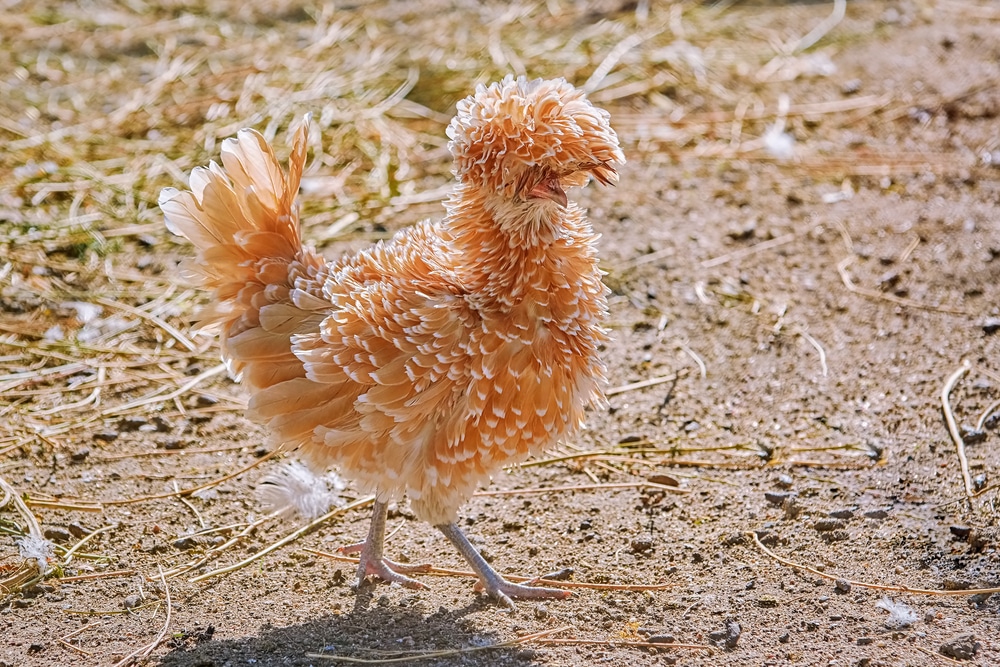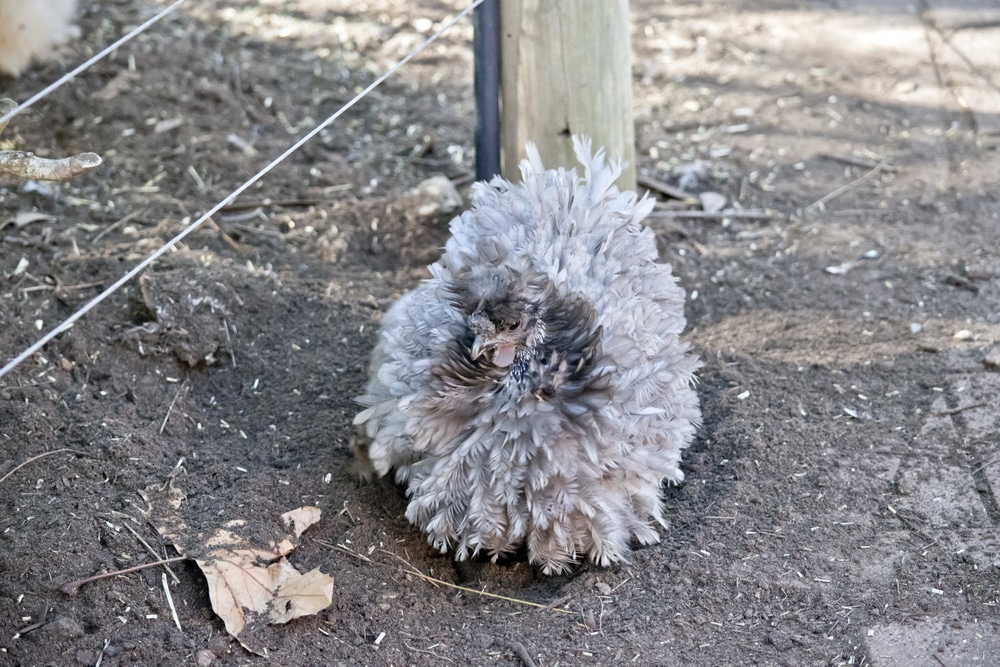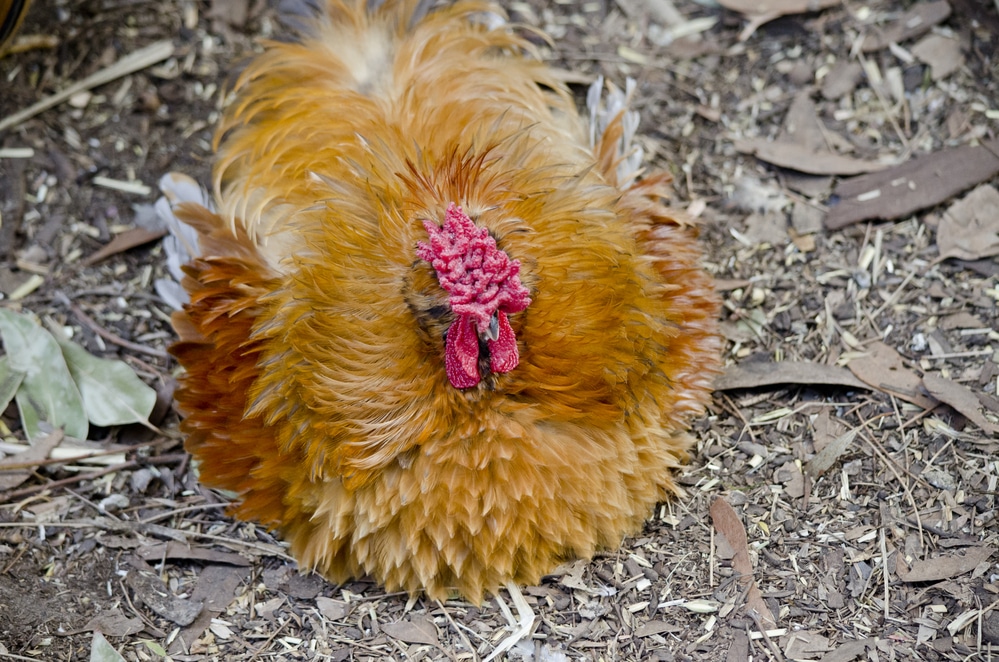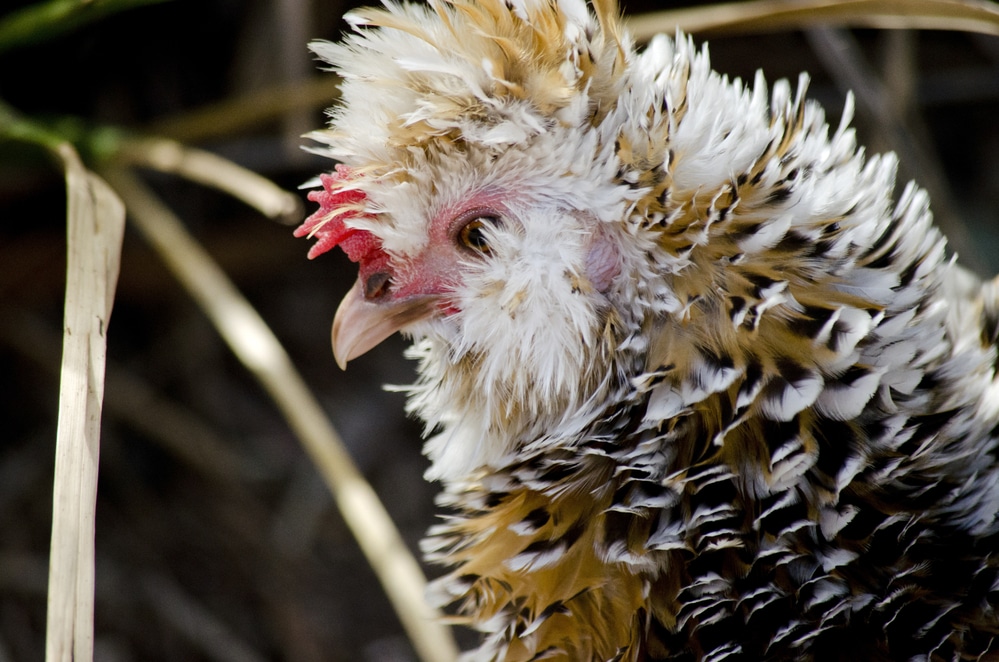You never thought you’d be interested in raising a chicken that looks like it had a bad experience with a clothes dryer, did you?
Well, think again. The Frizzle chicken is a breed that has been around for some time – since the 1600s! – but has recently risen to popularity.
This unique chicken breed is beloved around the world for its humorous appearance and its cuddly demeanor.
Here’s everything you need to know about the Frizzle chicken.
Frizzle Chicken Overview
Before we look at the details of these unique chickens, here’s an overview of their characteristics.
| Lifespan | 6 to 8 years |
| Weight | 5 to 9 pounds |
| Appearance | Curly feathers of a variety of colors |
| Egg Production | 2 to 4 eggs per week, about 150 per year |
| Egg Color | White or tinted |
| Good for Beginners? | Yes |
| Minimum Coop Space | About 4 square feet |
| Price | $5 to $8 per chick |
Background of the Frizzle Chicken
Many people assume that the Frizzle chicken is a new breed because it’s only reached the spotlight of late. However, that’s far from the truth. This chicken breed has actually been around for quite some time!
In fact, it was first mentioned in historical documents sometime in the 1600s. It also received a mention from Charles Darwin himself, who referred to what we know as a Frizzle chicken as Caffie Fowl.
Darwin stated that these birds were found mostly in India, assuming this from second-hand knowledge since he was never actually known to visit India himself.
That assumption holds water, though, as it’s true that the Frizzle gene first came about in the Far East – most likely, China or the East Indies.
As the bird rose in popularity, more and more were brought to western countries to be used as breeding stock.
Frizzling is actually caused by a unique genetic trait that several different breeds can have. Polish, Cochin, Japanese bantams, and even Plymouth Rocks have been known to Frizzle! There is a wide array of other birds who are believed to have this capability, too.
You can even cross other breeds with Frizzle chickens to maintain that frizzling gene. The Silkie, for example, is often crossed with Frizzle genes for a supremely adorable bird, which is often known as a Sizzle.
What Exactly is Frizzling?
Before we can go into more detail about what the Frizzle chicken is, it’s important to explain what frizzling actually is.
Frizzling is where the feathers of a bird begin to curl outward and upward, moving away from the body, instead of lying flat against them as they would in a typical hen. The feather shaft of the bird will start to curl and twist, giving the chicken a unique appearance.

It’s caused by a dominant gene that is incomplete, with one copy enough to create the frizzling effect. However, if both parents have the Frizzle gene, you’ll have an especially frizzly bird!
With any bird, the amount of frizzling that you see will vary depending on the prevalence of the “mf” gene.
However, it should be noted that most breeders do not actively breed Frizzle chickens with other Frizzled birds. This would give you Frazzle chickens instead of Frizzles. Most breeders instead breed normal hens with Frizzles, which gave you a mixture of chicks.
The reason why Frazzle chicks are not actively sought after by breeders is that they have exceptionally brittle features. These can break off at the slightest touch, meaning your chickens will develop patchy feathering or even become totally bald.
This is not attractive, but even worse, it’s not safe for your chicks – it makes it much more likely that they will succumb to the elements or that other chickens will bully them.
Furthermore, Frazzle chickens are prone to a variety of physical and heart issues, which can reduce the overall lifespan of your chickens.
Appearance

In many places, chickens with frizzled feathers are classified as their own breed. These places include Slovakia, Australia, Ireland, the Czech Republic, Germany, France, the UK, and Italy. However, in the United States, Frizzle is not the name of a breed but instead just a type of plumage.
As a result, these birds cannot be exhibited in the United States, although you can exhibit them as specimens of certain breeds, like Polish or Cochin.
Instead of being judged as the Frizzle breed, the bird will be judged based on its conformity to the breed standard.
While some breeds do quite well in the exhibition ring for this reason – the Cochin chicken is one good example – others do not.
For the most part, as a breed type, Frizzle chickens are classified in the South Asia, Philippines and Java class.
They have short beaks that are strong and yellow, with eyes that are a bright red in color. They have wattles and earlobes that are also a deep red.
They must be full-breasted with short, erect bodies that are broad and backed by large, long-winged tails. Their combs are upright and single.
Frizzle chickens generally have four toes per foot, with clean legs that are yellow in color. There are several colors available, which we will get to, but generally, black shading is allowed in some black/blue shades.
Weight varies depending on the exact breed of Frizzle you are raising. However, most will come in at around eight pounds for roosters and six pounds for hens. Bantams can weigh up to 27 ounces.
Now – here’s what Frizzles are really known for – their plumage!
At first glance, you might think you have misplaced your feather duster when you gaze upon this distinct breed These birds look like bundles of wild, windswept feathers with legs (almost like feather dusters, in fact!).
Depending on the breed, these chickens can either look tidy and curly or wild and windswept. All will look soft and not spiky, however.
The chicken will take the shape of its breed so there is some variation here. Frizzles are accepted in many colors, including:
- Black
- Buff
- Brown-red
- Black-red
- Blue
- Cuckoo
- Columbian
- Duckwing
- Red
- Pyle
- Spangled
- White
Although there are other colors around (breeders are constantly experimenting with new color variations and patterns), these are by far the most common shades.
They can be found in both standard and bantam size, as previously mentioned, but unlike other breeds where this is common, Frizzles are much more popular in their bantam forms.
Behavior

Frizzles don’t just look sweet and adorable – they are sweet and adorable!
These chickens are known for being friendly, gentle, and sweet. They are docile and soft-spoken and are great for families because they do well at being handled. It is not uncommon for Frizzle chickens to become lap chickens or even pets, in fact!
These beautiful birds are family-friendly, and they do well in the arena. However, you need to watch out that they don’t get bullied by other more assertive breeds.
This is extremely common with Frizzle chickens because they are so shy and they are much smaller than typical chickens.
Plus, their unique, somewhat bizarre feathering makes them an easy target for bullies.
Keep a close eye on your Frizzle chickens, especially when you first introduce them to the rest of the flock. They work well with similar breeds like Cochins, Polish, or Silkies, but watch out for feather-picking and other aggressive behaviors.
These can easily grow out of hand when you have Frizzle chickens.
Common Issues with Frizzles
Frizzle chickens do have some health issues to be aware of – most of these can be related directly to their feathering.
Here’s an overview of the issues they might face:
- They cannot fly to escape danger.
- They don’t handle cold weather well.
- The feathers don’t protect them from rain.
- The feathers could also impair their vision.
They can’t fly, so they need lower perches that are set down at a shorter height. They must be easier to access or the birds will pile together on the bedding. This is because the birds are so small and their feather patterns make it impossible to take flight.
Plus, if you decide you want to free-range your Frizzle chickens, you need to make sure the area is predator-proof. The birds cannot fly up and get away from danger.
You have to be mindful of the climate in which you are keeping your frizzle chickens, too. While some people report that their These chickens are hardy, this really depends on where you are raising your birds and what kind of breed they are descendants from.
In extreme cold, you need to keep an eye on your birds, as the feathering is not a wonderful insulator (as it is in other breeds of chickens).
Heavy precipitation, be it snow or rain, also needs to be avoided. Any inclement weather, in fact, can pose a difficult situation for your Frizzle chickens. The feathers aren’t great at keeping your chickens either cool or warm, so you need to make sure that every step is taken to ensure their comfort and safety.
The dense head feathering on a Frizzled bird can also interfere with its vision. You might need to trim the feathers at the tips ever so slightly from time to time, which will give them enough clearance to see.
Just keep in mind that you can’t cut back this feathering if you plan on exhibiting your birds. This will interfere with its eligibility for the show ring. There are methods you can take to control the feathers, though, so it’s worth looking into those if clipping or trimming is not an option.
Bear in mind that a bird that cannot see is not going to be happy chicken or a healthy chicken. If your chicken is having trouble seeing, you’ll know because it will behave in an exceptionally nervous manner and might panic any time you enter the coop or try to touch it.
If you can’t trim the feathers of your Frizzle for whatever reason, try incorporating a few tactics to acclimate your Frizzle chicken to its sightlessness. For example, when you enter the coop, you can try talking to your birds so they know that you are approaching.
Egg & Meat Production
In this section we detail the levels of egg / meat production that you should expect out of a frizzle chicken.
Is the Frizzle Chicken Good for Eggs?
Unfortunately, if you decide to raise a Frizzle chicken, it is going to be mostly for show and companionship than for anything else. These birds are not known for having an exceptional egg-laying ability. They are often described as “poor” in this area!
However, that’s not to say that you won’t get any eggs at all. You can still raise them for eggs if you’d like. These chickens will lay up to 150 cream-colored eggs each year (although they can also be tinted). That means you will get two or four eggs every week.
They go broody often and are exceptionally good mothers. They can be somewhat slower than regular chicks in feathering out, so you might have to keep them in the brooder longer if you decide to raise them starting when they are chicks.
You can increase the egg production of your Frizzle chicken by providing it with a diet that is high in protein. Protein helps improve egg production and can even help feather production in your delicate Frizzles.
Is the Frizzle Chicken Good for Meat?
Unfortunately, the small size of the Frizzle chicken means that it is not the best for meat production. You really can’t rely on a bird this small to produce a ton of meat for you. However, this all depends on the parent breed of the Frizzle chicken.
Some varieties are classified as heavy breeds, so depending on which type of Frizzle chicken you have, you may be able to get away with raising a Frizzle chicken for the dinner table – but don’t count on it. Instead, plan on raising your Frizzle chicken for exhibition or as a pet.

Benefits and Drawbacks of Raising These Chickens
Here are a few pros and cons of raising frizzles:
Benefits
Frizzle chickens are happy to be confined to runs or pens. They can also free-range with ease, but you’ll need to make sure you have some sort of protection in place for them. They aren’t great at flying, so your fences only need to be tall enough to keep predators out. A covered run is often necessary to prevent airborne predators from getting at these visually-impaired creatures.
Otherwise, Frizzled chickens are easy to tame and are very calm and easygoing. With its unique, frenzied appearance, you would expect this bird to be on high alert at all times, running around the coop in full panic mode. However, this bird is anything but crazed, instead behaving in a relaxed, laid down manner.
These chickens are also known for being good brooders and attentive mothers. Although they have some pretty ridiculous feathering, you won’t have to worry about them showing their love to and caring for their young ones. They will happily incubate their own eggs and take care of their young little chicks.
Because these chickens are small, you won’t need a ton of extra space in the coop for them, either. They can’t fly easily so the roost bars need to be lowered close to the ground. However, you only need a couple of square feet per bird in the coop (which is compared to the amount of space needed by larger breeds, like Jersey Giants, who can require up to four square feet in the coop).
Drawbacks
First and foremost, if you decide to breed and incubate your own Frizzle chickens, you need to be mindful of which chickens you use to do so.
Never, by any means, should you breed a Frizzle chicken with another of its kind. If you’re unsure how to properly breed Frizzles, you should avoid doing it.
Improper breeding can cause your chicks to be completely bald and to have a variety of other health issues. Instead, breed your Frizzle to another chicken breed like a Silkie.
Because of their curly, thin feathers, Frizzle chickens also need some level of protection from the cold. Their feathers are not very protective on their own, so they will need a warm, well-ventilated coop to prevent chilling in the winter.
You will also need to keep an eye on predators, namely dogs, cats, foxes, and hawks. Birds with frizzled feathers are easy targets for most predators because of their feathering that obstructs their vision.
Grooming your Frizzled bird on a regular basis is a good idea. Frizzles are no more prone to external parasites, like mites and lice, than other chicken breeds, but it can be more difficult for you, as the chicken owner, to find the pests hiding in the dense feathering of your Frizzles.
Therefore, you will want to make sure your birds have ample access to a dust bath and even consider adding some herbal essential oils into the bath to keep parasites at bay.
Frizzle chickens can also be difficult to find. Although you should be able to hunt down some Frizzle chicks at live poultry outlets or some local farms – as well as from online retailers – they aren’t always available in the common places where you can find more popular breeds, like New Hampshire.
Frizzles are not difficult to socialize, as they are friendly and exceptionally good-natured.
However, since they are so small, it is easy for the Frizzle to become a target for other chicken bullies.
You may want to raise medium-sized breeds that are known for being friendly instead of more aggressive or larger reeds.
Frequently Asked Questions
If you think this chicken breed is a good fit for you, it’s time to research as much as possible. Here are some questions you might be wondering.
What is the Difference Between Frizzle and Frazzle Chickens?
“Frazzle” refers to a chicken with a double dose of curled feathers, causing the feathers to be hard and sparse. Frazzle birds are an undesired result of breeding two Frizzled chickens. These chickens aren’t desirable because they have brittle feathers and are prone to more health concerns.
What are Sizzle Chickens?
You might hear the term “Sizzle” used interchangeably with “Frizzle.” A Sizzle chicken refers to a Frizzle that was born from a Silkie hen. Silkies give Frizzles special feathers, which is why they have a unique name. If the chicken doesn’t have Silkie feathers, it’s a Frizzle, not a Sizzle.
What Two Chickens Make a Frizzle?
A Frizzle can be bred using any two chicken breeds because the term refers to the type of feathers, not the breed characteristics. Most Frizzles are bred using Cochins, Pekins, or Polish.
Can Frizzled Chickens Fly?
While most chickens can fly, Frizzles are unable to fly. Their unique feathers make it impossible for them to lift themselves off the ground. So, keep their perches close to the ground so they can reach them.
Final Thoughts
The Frizzle chicken can be a charming addition to your backyard flock.
Although some care will need to be taken in terms of the unique health and grooming needs of this chicken, it is non-aggressive and will do well with your other more docile chicken breeds.
When it comes to exhibition and companionship, you really can’t beat this mesmerizing breed – it’s one of the best.
In fact, many people keep them as house chickens! While they aren’t the best if you’re looking for high meat or egg production, they are an absolute delight to look at if you are merely looking for a new chicken pet.
